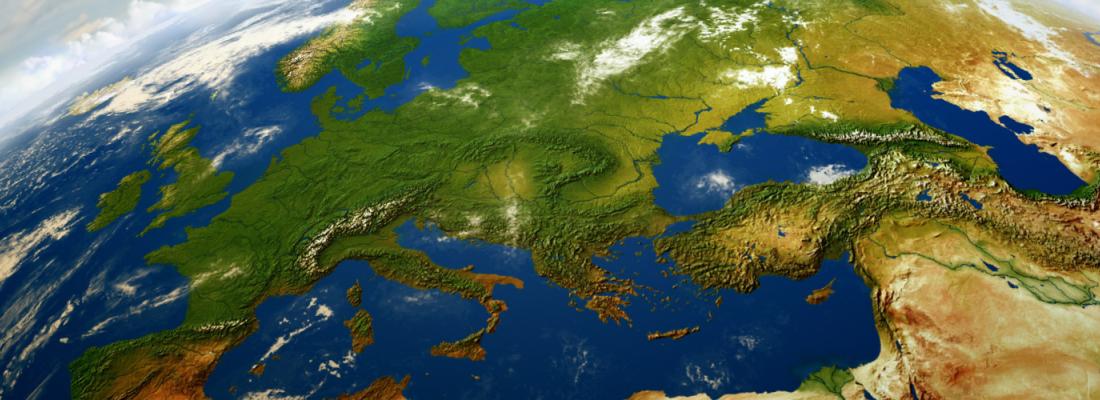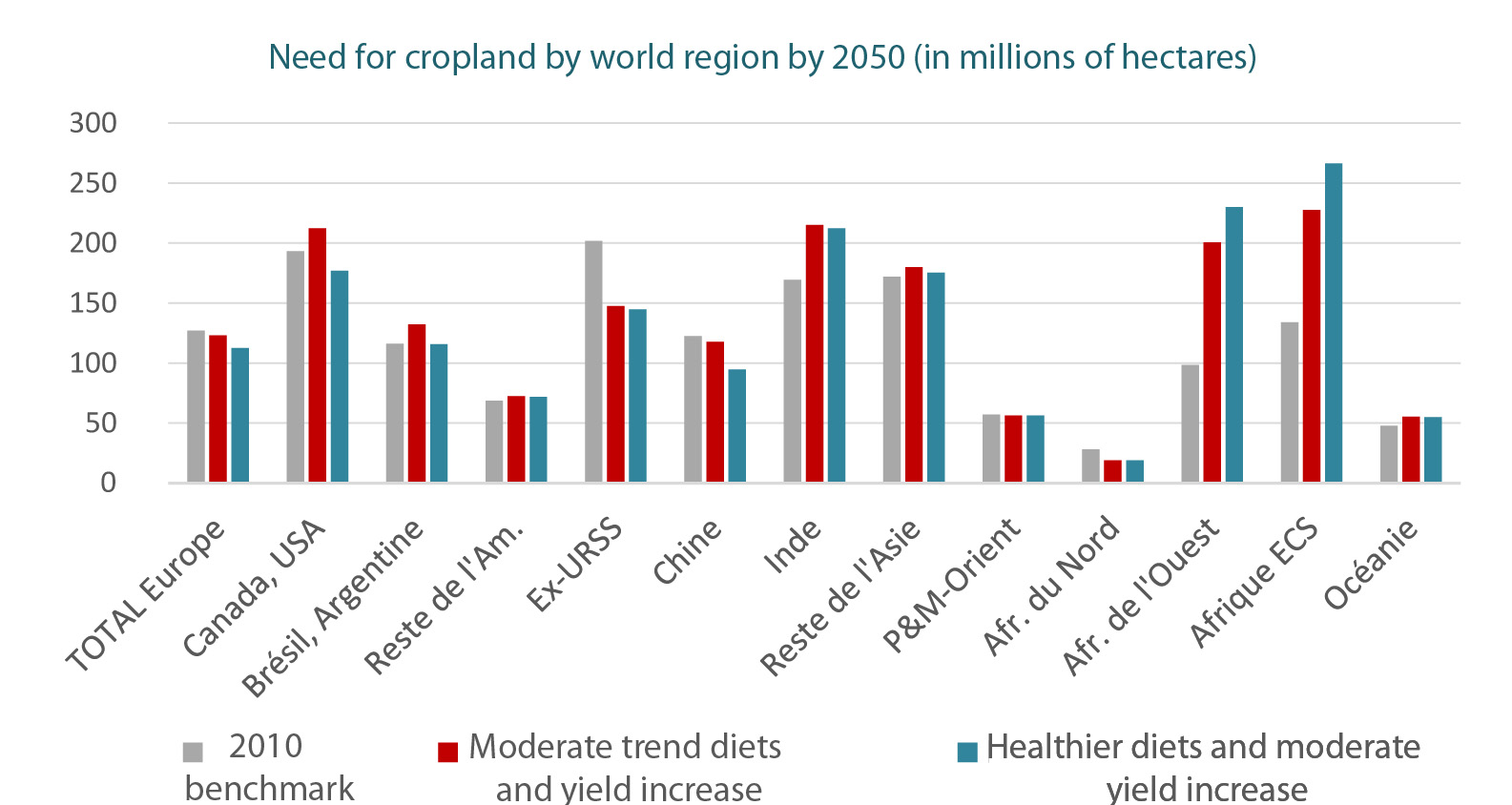Society and regional strategies Reading time 4 min
The role of European agriculture in world trade by 2050
Published on 14 February 2020

How can European agriculture contribute to global food security in 2050? Is there any room for manoeuvre to protect natural environments threatened by cropland expansion? Are these different objectives compatible? These are crucial issues for the governance of our societies in Europe and abroad. The INRAE study, the findings of which were presented and discussed on 14 February 2020, provides estimates drawn up with an unprecedented level of detail. It divides the world into 21 regions, with eight different regions in Europe to account for the disparate nature of agriculture on this continent, which is usually considered as a single region in global foresight literature.
Climate change and technical developments in agriculture: the two driving forces behind changes in crop yields
A series of simulations was produced using the GlobAgri-AE2050 model, developed by INRA and CIRAD and enhanced during this study. These simulations assess the production capacity, cropland and grassland requirements, and imports and exports in 2050 for each of the 21 world regions analysed. They take into account the impact of climate change on agricultural production and the availability of arable land. Developments in agricultural techniques – including input use, genetic improvement, technological innovations, etc. – and their effects on yield trends are also considered.
The increase in atmospheric CO2 concentration associated with climate change is favourable to photosynthesis, and therefore to plant yields, provided that plants’ water and nitrogen needs are met. This so-called “CO2 effect” could offset the deleterious effects of the rise in average temperatures and the decrease in rainfall affecting certain regions. It would thus lead to increases in average yields of between 1% and 8% depending on the region. Conversely, if the CO2 effect does not occur in the field, climate change could depress yields. That said, by 2050 the positive effect of technical developments will still be considerable. Assuming moderate technical developments, yields could increase by at least 20% to 40% depending on the region, with increases of up to 80% to 90% in sub-Saharan Africa if more sustained technical developments are achieved. To reflect these uncertainties regarding the CO2 effect and the dynamics of technical developments, two hypotheses for changes in crop yields were selected to simulate the scenarios and visualise the range of possible shifts by 2050.
Demographics and diets: drivers of demand
The demand for agricultural commodities for human consumption is driven by diets and population dynamics. The simulations were produced using two contrasting hypotheses. The first envisages so-called “trend” diets. It extends past trends, with a continuation of current diets in developed countries and a continued nutritional transition in developing countries. According to this hypothesis, daily caloric needs would not be met worldwide, with sub-Saharan Africa in particular remaining well below the nutritional recommendations in 2050. The second scenario, reflecting a “healthy” diet, projects a shift in consumption towards diets that more closely align with nutritional recommendations. With this situation, the diets adopted in the different regions of the world tend to converge. Only this option alone would enable sub-Saharan Africa to overcome its nutritional deficiencies.
Demography remains the major determinant of food demand. In Europe, where the population is expected to decline, the demand for food would stagnate with “trend” diets or fall with “healthy” diets. However, demand would explode in Africa regardless of the type of diet, thereby increasing the need for cropland and even dependence on imports, particularly when land availability is limited, such as in North Africa and the Middle East.

For the trend diet hypothesis, the total need for worldwide cropland could vary from +223 to -11 million hectares, compared to the 1.54 billion hectares of cropland in 2010, depending on whether yields rise moderately or more considerably by 2050. The need for arable land would be significant in sub-Saharan Africa and India, where projected yields in 2050 are lower and where increases in food demand will be greatest. A global transition to “healthy” diets would lead to a reduction in total caloric intake and meat consumption in developed countries. This could reduce the need for cropland in European regions and allow room for manoeuvre to develop strategies for the agricultural use of the land that would then be “freed up”. |
Leveraging Europe’s room for manoeuvre
By 2050, some European regions, mainly Eastern Europe, Poland and Germany, could see their needs for cropland decrease compared to current levels. This “land surplus” would, however, be far less than what the former USSR and – if healthier regimes are adopted globally – North America could have. Europe’s room for manoeuvre would be too small to contribute in a meaningful way to reducing cropland expansion in other regions of the world, particularly in sub-Saharan Africa. However, Europe could make use of these “surpluses” by growing more oilseed and protein crops. Doing so would reduce its dependence on soya imports from Latin America. The resulting reduction in the world market for soya meal could help limit cropland expansion in South America and protect the continent’s forest ecosystems. Another option within the agroecological transition would be to take advantage of these areas to develop less input-intensive cropping systems with lower yield levels without negatively impacting European production levels. France, the United Kingdom and the rest of Europe (northern European countries, Benelux and Ireland) would not be able to contribute as substantially to these strategies, as their need for cropland would likely increase by 2050 according to the scenario. Southern Europe is likely to be limited by its availability of arable land, particularly due to the effects of water stress, which lowers yields.
Such choices need to be debated and underpin other issues. For example, should we pay Latin America for the services provided by the Amazon rainforest if we reduce our soya imports? Will we be able to produce and export to Africa without undermining its food sovereignty? Under what conditions would these scenarios be realised, in terms of changes in agricultural practices, ecosystem services such as soil carbon sequestration or environmental impacts such as biodiversity?
This study provides insights to better inform and guide public policies. This research will be extended as part of the European Green Deal, which includes a commitment* to reduce the use of inputs in agriculture. The transition to pesticide-free agriculture is already part of a priority research programme in France.
* https://ec.europa.eu/commission/presscorner/detail/fr/fs_19_6728
Study documents to download (available in French only)
Summary 12 p, (pdf 3,26 MB)Press Release
Extended summary, (pdf 25 MB) Extended summary's appendix (pdf, 3,78 MB)
The simulations were produced using GlobAgri-AE2050, an agrifood product balance model developed for the INRA-CIRAD Agrimonde Terra foresight study and used in the INRA study on food dependency in North Africa and the Middle East. This model takes into account assumptions about changes in demographics, diets, crop intensities, crop and livestock yields and the availability of arable land. For each product in each region of the world, it seeks to find the balance between domestic agricultural commodity resources (production and imports) and their different uses (food and non-food, exports, etc., taking into consideration losses and waste). It enables step-by-step analyses, highlighting the weight of each factor taken into account the changing needs for cropland, agricultural yields and levels of trade.
|
This study was conducted by INRAE at the request of and with the support of the Pluriagri association, using the principles and method established by INRAE’s Delegation for Expertise, Foresight and Advanced Studies (DEPE). A group of about 20 experts and scientific contributors from various institutes and complementary fields (climatology, agronomy, genetics, ecophysiology, pedology, etc.) was asked to carry out the international scientific literature analysis for the study. Meanwhile, a scenario development group, comprising operators and several scientific experts, was formed to support the project team in developing hypotheses on changes to the different system variable and putting the scenarios together. |
Notes: Pluriagri is an association that brings together various field crop stakeholders: Avril, Confédération générale des planteurs de betterave, Unigrains and Crédit Agricole SA.
